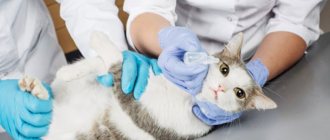Why you can't look a cat in the eyes
Domestic cats are not far removed from their wild counterparts and are by nature the same predators. So when we just look into their eyes out of curiosity, they may perceive it completely differently, for good reason.
All cats, unlike humans, have central and peripheral vision. In connection with this, the animal can focus its vision on several objects at once and notice all movements around it. Cats cannot concentrate their attention on a certain point for a long period of time, so they always look as if into the space in front of them. What is considered normal for us may seem like aggression to a domestic cat.
BUT IT IS IMPORTANT TO UNDERSTAND THAT THE MANIFESTATION OF AGGRESSION OF A CAT (non-acceptance of the gaze and, as a result, an attack) APPLIES ONLY TO STRANGERS AND UNPLEASANT PEOPLE; OR IF THE CAT HAS BEEN OFFENSED BEFORE (no matter the owner or a stranger), AND THE CAT WILL NOT TOLERATE A DIRECT LOOK FROM THE OFFENSER. Sometimes, if a pet looks its owner straight in the eyes, it is preoccupied or tense about something.
“Gaze” competitions, i.e. Tailed cats often arrange who will “reconsider” whom among themselves and in some cases they can end in a fight. When the owner of a domestic cat or a guest begins to look intently into the animal’s eyes and does not look away for a long time, the animal perceives this as a manifestation of aggression towards his person. The reaction to an overly close gaze can be the most unpredictable. The cat can prepare for defense or even attack the enemy and scratch him. This is due to the fact that a person seems to be a big predator to a cat.
If in such a situation the cat begins to focus its gaze on you, this can be regarded as fear, a feeling of danger or bad intentions. Aggression can be determined by the constricted pupils and the tense, frozen pose of the animal. In addition, all cats are, as mentioned earlier, very vindictive and you need to look at them as if by chance, immediately looking away or blinking often. In order for your pet to be able to trust you and not feel anxiety or fear, you should not give him an extra reason for this.
Mystical theories
One of the most important mystical stories about cats originated in Ancient Egypt. The myth tells of the Cat Goddess - a woman named Bastet with a cat's head. She was considered a source of kindness, beauty, and also fertility. It was believed that before giving birth, an animal had to live in the house of the expectant mother. Bast stood on a par with the greatest goddesses; in the name of the woman, cats built temples. She had two moods - good and evil. If the homeland was in danger, the woman reincarnated as Sekhmet - a woman with a lion's head.
The Egyptians believed that the power and ability to transform was given to the Goddess by the devil himself to transmit information to the afterlife. The cat's body transmitted the energy of life to the other world through invisible lines. Not a single witch of antiquity could do without such a guide, and cats were suitable for this role like no other. During the extermination of witches, several thousand cats also left the world.
People really believed that a cat was not just a four-legged friend, but also a transmitter of human energy to other worlds. It is impossible to feel how a cat takes power from another living creature. This happens through completely different levels beyond human control.
Only the most sensitive people could perceive the connection between the cat and the underworld. Each witch settled one, or even more, cat in her hut. As a rule, they had black fur. The black shade is considered something mystical, devilish and at the same time incredible.
This myth has caused people to firmly assert that by looking into a cat’s eyes, a person loses vitality. This can lead to unpredictable consequences, and even death.
In Ancient Rus', cats were relevant to the darkest force. It was believed that a pet should not be allowed into the bathhouse, since it was very hot there and the place looked like hell. In the sauna, cats can take on their true appearance and speak in a human voice. The scriptures never mention this animal, which is quite strange.
Important! Legends about the mystical influence of cats are still relevant. Communication with the subtle world is accepted as the most important reason that one should not look a cat in the eye.
Why does a cat look into a person's eyes?
If everything is clear about why domestic cats don’t like to be looked into the eyes, then the examining gaze and intentions of your pet can be quite difficult to understand. Usually the animal looks into the owner's eyes simply to recognize his mood at a given moment. Also, such a look helps her determine who is her enemy and who is her friend.
In addition, a close and long gaze from the cat can be a way of exchanging information. Sometimes communication with glances helps determine who is the real boss in the house. When an animal turns its eyes to the side first when crossing views, it means submission.
The science
Scientists explain that looking into a cat's eyes is acceptable, but only for a short time. Eye contact with a person causes hostility and discomfort in the cat. She is overcome by fear of danger.
Despite the fact that prolonged eye contact with a person is unpleasant for a cat, she herself can look into human eyes. This happens when an animal wants to lure out a treat or catch a person’s mood.
Prohibition from a biological point of view
In the past, the cat family had to endure a lot of hardships. The cats fought for food, shelter and their own safety. Prolonged eye contact infuriates the animal, and deep-seated survival instincts become more acute. The feeling of danger is due to the fact that the animal is afraid of losing its sleeping place or daily food.
You may notice that before a fight, cats first look intently at each other, making aggressive sounds, and their fur rises up. And if none of the participants takes their eyes off, the battle will take place and the cat will defend its territory.
Anatomical rationale
Cat eyes are different from human vision. The human eye sees only what it purposefully focuses on. But the cat clearly distinguishes all surrounding objects and simply may not understand what a person’s gaze means and what he wants. And therefore, a direct, prolonged gaze from a person can cause aggression and misunderstanding in a cat.
REFERENCE. A person can make visual contact with an animal, but only for a short time. It would be better to just blink at the cat, so he will understand that there is nothing to fear, and the owner is friendly.
About street cats
Outdoor cats are less prone to aggression when making eye contact with a person. The fact is that animals from the street need attention and care, as well as food. And they simply do not have the motivation to have a negative attitude towards a person’s eyes. They are ready to do anything for a treat or just affection from a person.
Features of a cat's vision
Let's look at the main features of cats' eyes:
- Compared to other animals, cats have fairly large eyes relative to the size of their entire body;
- The furry animal has no eyelashes, the protective effect is carried out by the eyelid;
- Cats have a wide angle of vision - 185 degrees;
- Up close, the pet sees absolutely nothing, for example, if the owner brings food to its face, then it can only smell it;
- Kittens are born with their eyes closed, after several weeks of their life they have light pupils;
- Unlike dogs, a cat's gaze is directed in the correct direction towards the object;
- In very bright light, the animal's pupils narrow and its vision becomes worse;
- The cat sees far enough, it tends to even consider an object located at a distance of 60 meters from it;
- If we consider the vision of all felines, then tigers are endowed with the best;
- It has not yet been established what colors animals see, but scientists assume that all their pictures are black and white;
- A cat's eyes can have different colors depending on the lighting.
How to look at a cat correctly
The character and temperament of cats, just like people, can vary greatly. Therefore, not every animal will be nervous when they look into its eyes. Thus, a domestic cat may become so accustomed to being often looked into the eyes that it will not pay any attention to it. In the same way, yard cats do not react in any way to direct gaze. But if your pet has a bad temper, then it is best not to look him in the eyes at all, so as not to anger him again.
There are several simple rules of behavior with cats:
- look at the animal briefly, periodically calmly looking away to the side;
- focus on the animal’s forehead or bridge of the nose, but in no case on the pupils, so it will not feel threatened;
- If, when looking at a cat, it shows aggression (crouches to the floor, twitches its tail, and its pupils become round), think about how you could scare or offend it, try to appease it with affection and delicious food to instill trust in it before making contact .
Among other things, the cat may constantly regard you as prey due to an unsatisfied hunting instinct. After all, every cat, even the most timid, remains a predator at heart. It’s better to please your pet with toys – a wind-up mouse or a ball. He will immediately stop being angry and happily join the game.
Opinion from the scientific approach
global $ads_google;
//data-ad-slot=”2475549904″ $ads_google = empty($ads_google) ? false : true; ?> if ($ads_google == false) {?> $ads_google = true; ?> } ?> So why can’t you look into a cat’s eyes for a long time ? The scientific view regarding the issue of looking into the eyes of cats gives the following interpretation: predators do not like it when people look closely into their eyes - this is a direct signal of threat and danger. The pupil narrows, the cat is stressed. From time immemorial, cats in their natural habitat have made eye contact before fighting. If a person does not want his pet to perceive him with aggression, then he should submit to nature and not try to penetrate the cat’s soul with his gaze.
Let's say a person ignores a warning. Then the cat may consider him ready for a fight and scratch his face. If the animal is a domestic animal that loves its owner, then it is much more difficult for it: instincts scream about the threat of a fight, but touching its owner with claws can be fraught with consequences. The psychology of cats is such that if you look into the eyes of a wild animal, there will be no consequences. It’s quite mysterious, but the answer is simple: tailed strays have nothing to share with humans, but it’s quite possible to get a treat, so why show aggression?
There is also a simple explanation: the structure of the human eye allows you to switch from peripheral vision to direct vision by moving your gaze to an object. The cat's eye is structured differently - there is no clear line between the two types of vision. Her gaze does not focus on something specific, but sees the whole picture at once, which requires considerable concentration. The animal does not catch what exactly the person is looking at, so it can react unpredictably.
The cat, which is believed to have nine lives, is a mysterious creature according to legends and fairy tales of many peoples. Even if your pet has lived nearby all her life, you should not force her instincts to show aggression with direct gaze. Isn't it better to show respect and kindness to your four-legged pet by making life in your home comfortable?
What if the cat looks into the eyes itself?
If the cat itself looks into your eyes, most likely, it is simply asking you for something or wants to convey some important idea: for example, to be petted or played with. Not all cats communicate using sound signals; some prefer to exchange glances. If you see that the cat is not showing aggression towards you, then you do not need to be afraid of this, but on the contrary, try to understand what she wants. And, of course, be sure to satisfy her desire.
With a low degree of probability, a situation may arise when the cat decides to attack you first. But at the same time, you will notice the corresponding signs of aggression - such as flattened ears, an arched back, a long tail lashing like an Indiana Jones whip. In this case, try not to be nervous, avoid the cat's gaze and move away from the danger zone. Once you are out of danger, analyze what could have caused the attack and, if possible, calm the animal.
As you can see, it is enough to be sensitive and follow a few simple rules to live in complete harmony with your pet!











